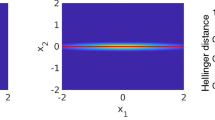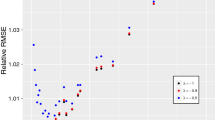Abstract
In parameter estimation, the maximum-likelihood method (ML) does not work for some distributions. In such cases, the maximum product of spacings method (MPS) is used as an alternative. However, the advantages and disadvantages of the MPS, its variants, and the ML are still unclear. These methods are based on the Kullback–Leibler divergence (KLD), and we consider applying the method of weighted residuals (MWR) to it. We prove that, after transforming the KLD to the integral over [0, 1], the application of the collocation method yields the ML, and that of the Galerkin method yields the MPS and Jiang’s modified MPS (JMMPS); and the application of zero boundary conditions yields the ML and JMMPS, and that of non-zero boundary conditions yields the MPS. Additionally, we establish formulas for the approximate difference among the ML, MPS, and JMMPS estimators. Our simulation for seven distributions demonstrates that, for zero boundary condition parameters, for the bias convergence rate, ML and JMMPS are better than the MPS; however, regarding the MSE for small samples, the relative performance of the methods differs according to the distributions and parameters. For non-zero boundary condition parameters, the MPS outperforms the other methods: the MPS yields an unbiased estimator and the smallest MSE among the methods. We demonstrate that from the viewpoint of the MWR, the counterpart of the ML is JMMPS not the MPS. Using this KLD-MWR approach, we introduce a unified view for comparing estimators, and provide a new tool for analyzing and selecting estimators.







Similar content being viewed by others
References
Cheng RCH, Amin NAK (1983) Estimating parameters in continuous distributions with a shifted origin. J R Stat Soc B 45(3):394–403
Ekström M (2001) Consistency of generalized maximum spacing estimates. Scand J Stat 28(2):343–354
Ekström M (2008) Alternatives to maximum likelihood estimation based on spacings and the Kullback–Leibler divergence. J Stat Plan Infer 138(6):1778–1791
Finlayson BA (1972) The method of weighted residuals and variational principles, with application in fluid mechanics, heat and mass transfer. Academic Press, New York
Huang C, Lin JG (2014) Modified maximum spacings method for generalized extreme value distribution and applications in real data analysis. Metrika 77(7):867–894
Jiang R (2013) A modified MPS method for fitting the 3-parameter Weibull distribution. In: QR2MSE 2013 - Proceedings of 2013 International Conference on Quality, Reliability, Risk, Maintenance, and Safety Engineering, 983–985
Ranneby B (1984) The maximum spacing method. An estimation method related to the maximum likelihood method. Scand J Stat 11:93–112
Smith RL (1985) Maximum likelihood estimation in a class of nonregular cases. Biometrika 72(1):67–90
Young LC (2019) Orthogonal collocation revisited. Comput Methods Appl Mech Eng 345:1033–1076
Author information
Authors and Affiliations
Corresponding author
Additional information
Communicated by Clémentine Prieur.
Publisher's Note
Springer Nature remains neutral with regard to jurisdictional claims in published maps and institutional affiliations.
We thank Maxine Garcia, PhD, from Edanz Group (www.edanzediting.com/ac) for editing a draft of this manuscript.
Rights and permissions
About this article
Cite this article
Kawanishi, T. Maximum likelihood and the maximum product of spacings from the viewpoint of the method of weighted residuals. Comp. Appl. Math. 39, 156 (2020). https://doi.org/10.1007/s40314-020-01179-7
Received:
Revised:
Accepted:
Published:
DOI: https://doi.org/10.1007/s40314-020-01179-7
Keywords
- Parameter estimation
- Kullback–Leibler divergence
- Bias
- Mean squared error
- Point collocation method
- Galerkin method




